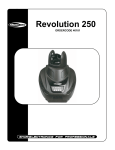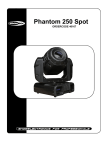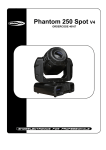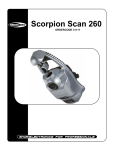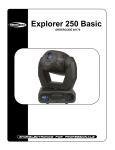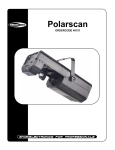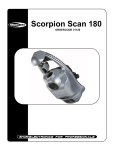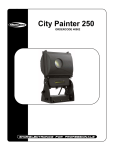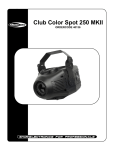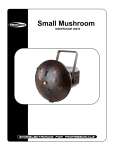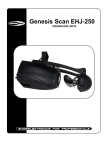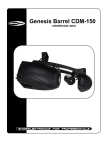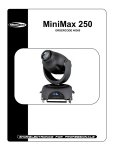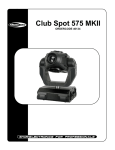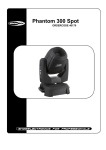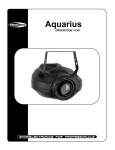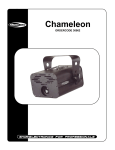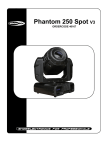Download Manual - AVOLITES
Transcript
Genesis 12 ORDERCODE 40155 Congratulations! You have bought a great, innovative product from Showtec. The Showtec Genesis 12 brings excitement to any venue. Whether you want simple plug-&-play action or a sophisticated DMX show, this product provides the effect you need. You can rely on Showtec, for more excellent lighting products. We design and manufacture professional light equipment for the entertainment industry. New products are being launched regularly. We work hard to keep you, our customer, satisfied. For more information: [email protected] You can get some of the best quality, best priced products on the market from Showtec. So next time, turn to Showtec for more great lighting equipment. Always get the best -- with Showtec ! Thank you! Showtec Showtec Genesis 12™ Product Guide Warning..…...................................................................................………………………………………….. Safety-instructions………………………………………………………………………………………….…. Operating Determinations……………………………………………………………………………………. Rigging…………………………………………………………………………………………………………. 2 2 3 4 Description..…..............................................................................……….………………………………… Features and Overview ………………………………...….……………….………….………………….…. Backside…………………………………………………...…...….……………….…………………...….…. 5 5 6 Installation...............................................................................…...…………………………………….….. Installing the Lamp ........................................................………………………………………..………… Lamp Adjustment.….......................................................………………………………………..………… 7 7 8 Set Up and Operation.....................................................................……..……………………………….… One Genesis ............................................................................………………………………………….. Multiple Genesis.........................................................................…....…………………………………... 9 9 9 DMX-Protocol…...................................................……………………………………………………………. Control Panel….............……....................................………………………………………………………. Control Mode........................................……………………………………………………………………… DMX addressing...................................……………………………………………………………………… Stand – alone mode...................................…………………………………………………………………. Functions control panel...................................……………………………………………………………… Functions outline.……….................................……………………………………………………………… Master/Slave mode...................................………………………………………………………………….. Channel settings……………………………………………………………………………………………….. 10 13 13 13 14 15 15 16 17 Rotating Gobowheel, Static Gobowheel and Colourwheel............ …………………………………..… 19 Maintenance...................................................................................………..………….…….……………… Changing the Lamp........................................................................…………………….………………… Replacing the Fuse........................................................................…………………….………………… 20 20 20 Troubleshooting............................................................................………………….………………….….. No Light, No Movement - All Products............................................………………….………………….. No Response to DMX ....................................................................………………….………………….. 21 21 21 Product Specifications.................................................................……………….…….………………….. 23 1 WARNING CAUTION! Keep this device away from rain and moisture! Unplug mains lead before opening the housing! FOR YOUR OWN SAFETY, PLEASE READ THIS USER MANUAL CAREFULLY BEFORE YOUR INITIAL START-UP! SAFETY INSTRUCTIONS Every person involved with the installation, operation and maintenance of this device has to: be qualified follow the instructions of this manual CAUTION! Be careful with your operations. With a dangerous voltage you can suffer a dangerous electric shock when touching the wires! Before your initial start-up, please make sure that there is no damage caused by transportation. Should there be any, consult your dealer and do not use the device. To maintain perfect condition and to ensure a safe operation, it is absolutely necessary for the user to follow the safety instructions and warning notes written in this manual. Please consider that damages caused by manual modifications to the device are not subject to warranty. This device contains no user-serviceable parts. Refer servicing to qualified technicians only. IMPORTANT: The manufacturer will not accept liability for any resulting damages caused by the non-observance of this manual or any unauthorized modification to the device. • • • • • • • • • • • • • • • Never let the power-cord come into contact with other cables! Handle the power-cord and all connections with the mains with particular caution! Never remove warning or informative labels from the unit. Never use anything to cover the ground contact. Never run the device without lamp! Never ignite the lamp if the objective-lens or any housing-cover is open, as discharge lamps may expose and emit a high ultraviolet radiation, which may cause burns. Never lift the fixture by holding it at the projector-head, as the mechanics may be damaged. Always hold the fixture at the transport handles. Never look directly into the light source. Never leave any cables lying around. Do not insert objects into air vents. Do not connect this device to a dimmerpack. Do not switch the device on and off in short intervals, as this would reduce the lamp’s life. Do not touch the device’s housing bare-handed during its operation (housing becomes very hot). Do not shake the device. Avoid brute force when installing or operating the device. Only use device indoor, avoid contact with water or other liquids. Only operate the fixture after having checked that the housing is firmly closed and all screws are tightly fastened. 2 • • • • • • • • • • • • • • • • • • • • Only operate the device after having familiarized with its functions. Avoid flames and do not put close to flammable liquids or gases. Always replace the lamp, when it is damaged or deformed due to the heat. Always keep case closed while operating. Always allow free air space of at least 50 cm around the unit for ventilation. Always disconnect power from the mains, when device is not used, before cleaning or when replacing lamp! Only handle the power-cord by the plug. Never pull out the plug by tugging the power-cord. Make sure that the device is not exposed to extreme heat, moisture or dust. Make sure that the available voltage is not higher than stated on the rear panel. Make sure that the power-cord is never crimped or damaged. Check the device and the power-cord from time to time. If the lens is obviously damaged, it has to be replaced. So that its functions are not impaired, due to cracks or deep scratches. If device is dropped or struck, disconnect mains power supply immediately. Have a qualified engineer inspect for safety before operating. If the device has been exposed to drastic temperature fluctuation (e.g. after transportation), do not switch it on immediately. The arising condensation water might damage your device. Leave the device switched off until it has reached room temperature. If your Showtec device fails to work properly, discontinue use immediately. Pack the unit securely (preferably in the original packing material), and return it to your Showtec dealer for service. For adult use only. The device must be installed out of the reach of children. Never leave the unit running unattended. For replacement use lamps and fuses of same type and rating only. Allow time to cool down, before replacing lamp. This device falls under protection class I. Therefore it is essential to connect the yellow/green conductor to earth. During the initial start-up some smoke or smell may arise. This is a normal process and does not necessarily mean that the device is defective. Repairs, servicing and electric connection must be carried out by a qualified technician. WARRANTY: Till one year after date of purchase. CAUTION ! EYEDAMAGES !. Avoid looking directly into the light source. (meant especially for epileptics) ! OPERATING DETERMINATIONS This device is not designed for permanent operation. Consistent operation breaks will ensure that the device will serve you for a long time without defects. The minimum distance between light-output and the illuminated surface must be more than 1.3 meter. The maximum ambient temperature ta must never be exceeded. If this device is operated in any other way, than the one described in this manual, the product may suffer damages and the warranty becomes void. Any other operation may lead to dangers like short-circuit, burns, electric shock, lamp explosion, crash etc. You endanger your own safety and the safety of others! 3 Rigging Please follow the European and national guidelines concerning rigging, trussing and all other safety issues. Do not attempt the installation yourself ! Always let the installation be carried out by an authorized dealer ! Procedure: • • • • • If the projector is lowered from the ceiling or high joists, professional trussing systems have to be used. Use a clamp to mount the projector, with the mounting-bracket, to the trussing system. The projector must never be fixed swinging freely in the room. The installation must always be secured with a safety attachment, e.g. an appropriate safety net or safety-cable. When rigging, derigging or servicing the projector, always make sure, that the area below the installation place is blocked and staying in the area is forbidden. Improper installation can cause serious damage to people and property ! Connection with the mains Connect the device to the mains with the power-plug. Always pay attention, that the right color cable is connected to the right place. Cable Pin International BROWN FASE L BLUE NUL N YELLOW/GREEN EARTH Make sure that the device is always connected properly to the earth! 4 Description of the device Features The Showtec Genesis 12 is a light effect with high output and great effects. • 1 Color-wheel with 11 coloured gobos, and open • 1 rotating Gobo-wheel with 1 glass, 1 multicolor dichroic and 6 metal interchangeable gobos plus open • 1 Static Gobo-wheel: 11 metal gobos and open • DMX-control via standard DMX-controller • 12 DMX-control channels required • Strobe-effect with adjustable speed (1 - 10 flashes/sec.) • High-speed 3D, 3-facet and 5-facet Prism / Frost Filter • Sound-controlled via built-in microphone • Lamp MSD 200, MSD 250 or HSD 250 • Fuse T3,5A / 250V Overview 1 2 3 4 Fig. 1 5 6 1) Mounting bracket 2) Fixation screw 3) Mirror 4) Lens 5) Display 6) Menu / Select buttons 5 Backside 7 8 9 Fig. 2 7) DMX signal connector (OUT) 8) DMX signal connector (IN) 9) IEC power connector / Fuse 6 Installation Installing the Lamp The Showtec Genesis 12 uses the MSD 200 (ordercode 80904P), MSD 250/2 (ordercode 80926P) or HSD 250 (ordercode 80933O) reflectorbulb as manufactured by all popular manufacturers. Use only the appropriate lamp for your unit. Note that, product versions that use other lamps, may be offered in the future. Check your product specification label for information. Always disconnect from electric mains power supply before changing lamps. The lamp has to be replaced when it is damaged or deformed due to the heat. Do not install lamps with a higher wattage! Lamps with a higher wattage generate temperatures the device was not designed for. Damages caused by non-observance are not subject to warranty. Procedure : 1. Loosen the 2 screws on the back of the housing. 2. Gently remove the metal housing. 3. Read lamp instructions. Do not touch the lamp bulb glass. (See Figure 3.) Oil on hands shortens the lamp life. (If you touch the bulb glass, wipe off the glass with a clean, lint-free towel and rubbing alcohol.). 4. Insert the lamp pins into the small holes in the lamp socket. You can adjust the distance between the lamp and the lens (screw A) on the back. 5. Put the lamp cover back and fasten the screws snugly. Then put the metal housing back and fasten the screws snugly 1 2 3 4 Fig. 3 Backside Lamp Board Fig. 4 7 Lamp Adjustment You can adjust the lamp’s position by turning the screws A (closer/further to the reflector) and B (left/right to center the lamp to the gobo-wheel). The lamp position is set in the factory. As the lamps, which can be used, differ from manufacturer to manufacturer, it can be necessary to readjust the position. The lamp must be readjusted e.g., if the light does not seem to be evenly distributed within the ray of light. Ignite the lamp and focus the ray of light on an even surface (wall). As the optimal distance between the lamp and the lens was already set during the installation with screw "A", only the "Hot Spot" ( the brightest part of the ray of light) must be centered. Turn in addition screw "B". If the Hot Spot appears too bright, you can weaken its intensity, by moving the lamp closer to the reflector. Turn in addition screw "A", until the light is evenly distributed. If the light at the outside edge of the ray of light appears brighter as in the center, the lamp is too close to the reflector. In this case move the lamp away from the reflector, until the light is evenly distributed and the ray of light appears bright enough. 8 Set Up and Operation Follow the directions below, as they pertain to your preferred operation mode. Before plugging the unit in, always make sure that the power supply matches the product specification voltage. Do not attempt to operate a 120V specification product on 230V power, or vice versa. One Genesis 1. Fasten the effect light onto firm trussing (Use a 30-kg rated or stronger C-clamp fastened onto the Genesis ). Leave at least 1 meter on all sides for air circulation. 2. Plug one end of the electric mains power cord into the IEC socket on the unit. Then plug the other end of the cord into a proper electric power supply socket. 3. Turn on the music. If F8 (Audio) is set, then the fixture will react to the beat of the music. Multiple Genesis 1. Fasten the effect light onto firm trussing (Use a 30-kg rated or stronger C-clamp fastened onto the Genesis ). Leave at least 1 meter on all sides for air circulation. 2. Use a 3-p XLR cable to connect the Genesis’s and other devices. The pins: 1. 2. 3. Earth Signal Signal + 3. Link the units as shown in (figure 6), Connect a DMX signal cable from the first unit's DMX "out" socket to the second unit's "in" socket. Repeat this process to link the second, third, and fourth units. 4. Supply electric power: Plug electric mains power cords into each unit's IEC socket, then plug the other end of the mains power cord into proper electric power supply sockets, starting with the first unit. Do not supply power before the whole system is set up and connected properly. 5) Press , until the display shows FA-n or FA-y (with actually stored address). . Select , the display shows “ . Then select F8-y (audio6) Select , the display shows controlled) on the master device. Only one fixture can be the master. 7) On the slave devices you must select FA-n and F8-n. The DMX light on the slave devices will start blinking. The slave devices must have address A001. Multiple Genesis Set Up DMX-Set up Master/Slave Set up Fig. 6 Note : Link cables and dip switches before connecting electric power 9 DMX Protocol This DMX is set as default (F1-y), you’ve got 12 channels. Channel 1 – Shutter, Strobe 0-31 32-63 64-95 96-127 128-159 160-191 192-223 224-255 Shutter closed No function (Shutter open) Strobe-effect from slow to fast (max. 10 flashes/sec.) No function (Shutter open) Sound-active strobe Pulse effect in sequence from slow to fast (forwards) Pulse effect in sequence from slow to fast (backwards) No function (Shutter open) Channel 2 – Dimmer intensity 0-255 Gradual adjustment intensity from 0-100% Channel 3 – Color-wheel Linear color change following the movement of the slider. In this way you can stop the color-wheel in any position – also between two colors creating double-colored beams. Between 194 - 223 and between 226 255, the color-wheel rotates continuously the so-called “Rainbow” effect. 0-9 10-20 21-31 32-41 42-52 53-63 64-73 74-84 85-95 96-105 106-116 117-127 128 129-190 129-133 134-139 140-144 145-150 151-155 156-161 162-166 167-172 173-177 178-183 184-189 190 191-193 194-223 224-225 226-255 Open / White Turquoise Red Cyan Light green UV Light blue Yellow Green Pink Blue Orange Stop Linear color change following the movement of the slider (color backward change) Orange Blue Pink Green Yellow Light blue UV Light green Cyan Red Turquoise Open/white Sound-active color Forwards rainbow effect from fast to slow Stop Backwards rainbow effect from slow to fast 10 Channel 4 – Static Gobo-wheel 0-9 Open 10-20 Gobo 1 21-31 Gobo 2 32-41 Gobo 3 42-52 Gobo 4 53-63 Gobo 5 64-73 Gobo 6 74-84 Gobo 7 85-95 Gobo 8 96-105 Gobo 9 106-116 Gobo 10 117-127 Gobo 11 128-132 Open 133-217 Shaking gobo with variable speeds 133-139 Shaking Gobo 1 140-147 Shaking Gobo 2 148-155 Shaking Gobo 3 156-163 Shaking Gobo 4 164-171 Shaking Gobo 5 172-179 Shaking Gobo 6 180-187 Shaking Gobo 7 188-195 Shaking Gobo 8 196-203 Shaking Gobo 9 204-210 Shaking Gobo 10 211-217 Shaking Gobo 11 218-223 Sound-active static Gobo 224-225 Open 226-255 Gobo-wheel rotating from slow to fast Channel 5 – Rotating Gobo-wheel 0-13 Open 14-27 Rotating gobo 1 (glass) 28-41 Rotating gobo 2 (metal) 42-55 Rotating gobo 3 (metal) 56-69 Rotating gobo 4 (metal) 70-83 Rotating gobo 5 (metal) 84-97 Rotating gobo 6 (metal) 98-111 Rotating gobo 7 (metal) 112-125 Rotating gobo 8 (glass) 126-137 Open 138-217 Shaking gobo with variable speed 138-147 Shaking gobo 1 148-157 Shaking gobo 2 158-167 Shaking gobo 3 168-177 Shaking gobo 4 178-187 Shaking gobo 5 188-197 Shaking gobo 6 198-207 Shaking gobo 7 208-217 Shaking gobo 8 218-223 Sound-active gobo 224-225 Open 226-255 Gobo-wheel rotating from slow to fast 11 Channel 6 - Rotating gobo index, rotating gobo rotation 0-127 128-189 190-193 194-255 Gobo index Forwards rotating from fast to slow No rotation Forward rotating from slow to fast Channel 7- Focus 0-255 Continuous adjustment from far to near Channel 8 - Prism effect-wheel 0-50 51-100 101-150 151-200 201-255 Open 3-facet-prism 5-facet-prism 3D-prism Frost-filter Channel 9 - Prism rotation 0 1-126 127-128 129-255 No rotation Forwards rotating from fast to slow No rotation Backwards rotating from slow to fast Channel 10 - Mirror Horizontal movement (Pan) Push the slider up, in order to move the mirror horizontally (PAN). Gradual mirror adjustment from one end of the slider to the other (0-255, 128-center). The mirror can be turned by 180°and stopped at any position you wish. Channel 11 - No function Channel 12 - Mirror Vertical movement (Tilt) Push the slider up, in order to move the mirror vertically (TILT). Gradual mirror adjustment from one end of the slider to the other (0-255, 128-center). The mirror can be turned by 45°and stopped at any position you wish. 12 Control Panel When the indicator light is on, means the Genesis is working Fig. 7 A. LED B. Display C. [ENTER] Button D. [MODE] Button E. Up Button F. Down Button Control Mode The fixtures are individually addressed on a data-link and connected to the controller. The fixtures respond to the DMX signal from the controller. (When you select the DMX address and save it, the controller will display the saved DMX address the next time.) DMX Addressing The control panel on the front side of the base allows you to assign the DMX fixture address, which is the first channel from which the Genesis will respond to the controller. Please note when you use the controller, the unit has 12 channels. When using multiple Genesis’s, make sure you set the DMX addresses right. Therefore, the DMX address of the first Genesis should be 1(A001); the DMX address of the second Genesis should be 1+12=13(A013); the DMX address of the third Genesis should be 13+12=25(A025), etc. Please, be sure that you don’t have any overlapping channels in order to control each Genesis correctly. If two or more Genesis’s are addressed similarly, they will work similarly. ) For address settings, please refer to the instructions under ”Addressing’ (menu Controlling: After having addressed all Genesis fixtures, you may now start operating these via your lighting controller. Note: After switching on, the Genesis will automatically detect whether DMX 512 data is received or not. If there is no data received at the DMX-input, the “LED “ on the control panel will not flash. The problem may be: - The XLR cable from the controller is not connected with the input of the Genesis. - The controller is switched off or defective, the cable or connector is detective, or the signal wires are swapped in the input connector. Note: It’s necessary to insert a XLR termination plug (with 120 Ohm) in the last fixture in order to ensure proper transmission on the DMX data link. 13 Remotely controllable functions Colour-wheel The Genesis contains a colour-wheel with 12 colour positions. 11 dichroic colours and one white. The colour-wheel can be positioned between two adjacent colours in any position. It is also possible to rotate the colour-wheel continuously at different speeds ( “Rainbow effect” in both directions). Static gobo-wheel This wheel has 11 metal gobos and open. The gobos have an outside diameter of 28mm and an image diameter of 17mm. Rotating gobo-wheel The rotating gobo-wheel includes 6 metal gobos, 1 glass gobo and 1 multicolor dichroic gobo rotating in both directions, indexable, rotating gobo wheel continuous rotation slow to fast. The metal gobos have an outside diameter of 28mm and an image diameter of 17mm. The glass and dichroic gobos have an outside diameter of 28mm and an image diameter of 17mm. Effect-wheel The prism-wheel includes a 3-facet prism, a 5-facet prism, a tread prism and a frost-filter. All the prisms can rotate in both directions with different speeds. Focus Motorized focus enables the beam to be focused anywhere on stage. Shutter/Dimmer/Strobe The dimming (0-100%) is provided by a simple mechanical shutter unit. This unit may also be used for strobe effect (1-10 flashes per second). Stand-alone Mode The fixtures on a data-link are not connected to the controller, but can execute pre-set programs, which can be different for every fixture. To set the program to be played, see the “Stand-alone setting “ ( menu ) Stand-alone operation” can be applied to a single fixture (the fixture may be set to the master/slave mode or controller mode) or to multiple fixture operating synchronously. For synchronous operation of multiple fixtures the fixtures must all be connected on a data-link and one of them is set as a master (master mode) and the rest as slaves (slave mode). The DMX address of all the and on that particular slave address only one fixture can be connected. To the slaves are assigned to fixture as the master or slave, see “Addressing” (menu ). If the master fixture resets or runs a test (program), all slaves will execute these acts too. You can’t play or edit any program on a slave, if the master is switched on and connected to the master/slave chain. Note: Disconnect the fixtures from the DMX controller before master/slave operating, otherwise data collisions can occur and the fixtures will not work properly! It’s necessary to insert the XLR termination plug (with 120 Ohm ) into the input of the master fixture and into the output of the last slave fixture in the data-link, in order to ensure proper transmission on the data link. From the master’s control panel it is possible to control any slave in a master/slave chain. 14 Functions control panel The control panel is situated on the front of the base and offers several features. You can simply set the DMX address, master/slave mode, make a reset and also use many functions for setting purposes. button [MODE] - press this one until the The main menu of the control panel is accessed by pressing the display shows (with actually stored address). Browse the menu by pressing or buttons - the display will show : Press if you wish to select one of them. The functions are described in the following sections and the function hierarchy is shown below. Functions outline - RX-12 - Display the type of the fixture - Version 101 - Display the version of the fixture - Reset - Make an internal check - Function A - Set the fixture as the master - Function B - Resetting partial function - Function C - Invert display direction - Function 1 - Preset the DMX-protocol - Function 2 - No function - Function 3 - No function - Function 4 - No function - Function 5 - Invert the pan-movement - Function 6 - Invert the tilt-movement - Function 7 - Reset all functions - Function 8 - Run programs via the built-in microphone - Function 9 - Run a built-in program - Pass - Confirm information - Hour 000 - Display the total number of the operation hours of the fixture (from H001 to H999) - Address 001 - Display the DMX address of the fixture (from A001 to A511) - - - - - - In this state, you can reset the counter. - Default - Appear when the counter is being reset. - No - Don’t select the present function - Yes - Select the present function 15 Addressing With this menu you can set the DMX address or address a fixture as a master/slave. - DMX addressing 1) Press , until the display shows . to confirm, the display will show 2) Press And press 3) Press and (with actually stored address). to select the required address , press to confirm. , the chosen address is shown on the display. - Master / slave addressing - Master 1) Press , until the display shows 2) If the display shows message , the display shows Select Select , the display shows “ or (with actually stored address). (with actually stores address). . , (with actually stored address). If you want to address no master or slave, don’t select . 3) Only one fixture can be the master. Up to the 9 slaves may be connected to the master. Note: Disconnect the fixture from the DMX controller before master/slave operating, otherwise data collisions can occur and the fixtures will not work properly! and the remote In master/slave mode, the master fixture can execute the built-in program , all the slave fixtures will work the same. control function In master/slave mode, the built-in program ID prior to the remote control function. When operation, you can identify the master fixture from the slave fixture easily. The master doesn’t connect any cable to the DMX input plug. When execute the remote control, the display of the master will flash according to the music, while the display of the slave will light. - Slave control This function allows you to control the slaves from the master’s control panel in a master/slave operation. 1) Select this function from the main menu and press until the display shows (with actually stored address) 2) Press or , until the display shows , Select the desired slave and press . The display will show ( with actually stored address ) Note: This function is available for the master fixture only. In master/slave mode, the setting of the and in the slave, must be the same as master. And the setting of the and can be set randomly. The function ” and in the slavemode, you must choose ( DMX address of all the slaves are assigned to ). (from fixture 1 to fixture 9). 16 Operating options These options allow you to modify the Genesis 12’s operating behavior. to select the desired option, Press Press . To return to the menu, press to cancel the desired option and press to set the value. The function makes it possible to select from the 12 DMX – channels settings, Use to select the desired channel setting ( ) and press to confirm or to cancel. Press to return to the menu. Channels settings Channel 1 2 3 4 5 6 7 8 9 10 11 12 (default) Shutter, Strobe Dimmer Color-wheel Static Gobo-wheel Rotating Gobo-wheel Rotating gobo index, rotating gobo rotation Focus Prism-wheel Prism rotation Pan No function Tilt Please refer to chapter “ DMX Protocol” for a detailed description. – Pan reverse until the display shows or . This function allows you to invert the pan movement. Press If the display shows (with actually stored address). Press , the display shows . , the display shows , (with actually stored address ). If you want address no pan reverse, Press don’t select . – Tilt reverse This function allows you to invert the pan movement. Press until the display shows or . If the display shows (with actually stored address). Press , the display show s . , the display shows , (with actually stored address ). If you want address no Tilt reverse, Press don’t select . - Reset function This option enables the Genesis 12 to index all effects (function) and return to their standard positions. , until the display shows or . Press (with actually stored address). Press , the display shows . If the display shows 17 Press to run a reset. The option enables the Genesis to index all effects (functions) and return to their , ( with actually stored address ). If you want address no reset, standard positions, the display shows don’t select . - Music trigger The Genesis 12 enables the sound control of the running programs via the built-in microphone. Press , until the display show s or . If the display shows (with actually stored address). Press , the display shows . to music trigger. The display shows , (with actually stored address ). If you want address no Press music trigger, don’t select . - Playing program This function allows you to run a built -in program. Press , until the display shows (with actually stored address). Press , the display shows If the display shows Press to play the program. the display shows address no playing program don’t select . or . . , ( with actually stored address ). If you want -Master / Slave - Reset Partially This function allows you to reset all the channel functions of the fixture to the standard value “0” except the functions of the head’s movement (Pan, Tilt, Pan Fine, Tilt Fine). , until the display shows or . Press the If the display shows (with actually stored address). Press , the display shows . Press to reset partially, the display shows partially, don’t select . ( with actually stored address ). If you don’t want reset - Display reverse With this function, you can adjust the display by 180º. Press , until the display shows (with actually stored address). Press , the display shows If the display shows Press to play the program. The display shows . address no playing program, don’t select or . . , ( with actually stored address ). If you want 18 Colorwheel Static Gobowheel Fig. 8 Fig. 9 Rotating Gobowheel Fig. 10 19 Maintenance The operator has to make sure that safety-relating and machine-technical installations are to be inspected by an expert after every four years in the course of an acceptance test. The operator has to make sure that safety-relating and machine-technical installations are to be inspected by a skilled person once a year. The following points have to be considered during the inspection: 1. All screws used for installing the device or parts of the device have to be tightly connected and must not be corroded. 2. There may not be any deformations on housings, fixations and installation spots. 3. Mechanically moving parts like axles, eyes and others may not show any traces of wearing. 4. The electric power supply cables must not show any damages or material fatigue. The Showtec Genesis 12 requires almost no maintenance. However, you should keep the unit clean. Otherwise, the fixture’s light-output will be significantly reduced. Disconnect the mains power supply, and then wipe the cover with a damp cloth. Do not immerse in liquid. Wipe lens clean with glass cleaner and a soft cloth. Do not use alcohol or solvents. The front lens will require weekly cleaning, as smoke-fluid tends to build up residues, reducing the lightoutput very quickly. The cooling-fans, dichroic colour-filters, the gobo-wheel, the gobos and the internal lenses should be cleaned monthly with a soft brush. Please clean internal components once a year with a light brush and vacuum cleaner. Keep connections clean. Disconnect electric power, and then wipe the DMX and audio connections with a damp cloth. Make sure connections are thoroughly dry before linking equipment or supplying electric power. Changing the Lamp 1. Disconnect mains power supply, and allow 15 minutes to cool down. Loosen the 2 screws on the back of housing. 2. Gently remove the metal housing. 3. Follow directions for installing a new lamp, page 7. Replacing a Fuse Power surges, short-circuit or inappropriate electrical power supply may cause a fuse to burn out. If the fuse burns out, the product will not function whatsoever. If this happens, follow the directions below to do so. 1. Unplug the unit from electric power source. 2. Insert a flat-head screwdriver into a slot in the fuse cover. Gently pry up the fuse cover. The fuse will come out. 3. Remove the used fuse. If brown or unclear, it is burned out. 4. Insert the replacement fuse into the holder where the old fuse was. Reinsert the fuse cover. Be sure to use a fuse of the same type and specification. See the product specification label for details. 20 Troubleshooting No Light This troubleshooting guide is meant to help solve simple problems. If a problem occurs, carry out the steps below in sequence until a solution is found. Once the unit operates properly, do not carry out following steps. If the light effect does not operate properly, refer servicing to a technician. Response: Suspect three potential problem areas: the power supply, the lamp, the fuse. 1. Power supply. Check that the unit is plugged into an appropriate power supply. 2. The lamp. Replace the old lamp with a new one with the same specifications. See page 7 for replacing lamps. 3. The fuse. Replace the fuse. See page 20 for replacing the fuse. No Response to DMX Response: Suspect the DMX cable or connectors, a controller malfunction, a light effect DMX card malfunction. 1. Check the DMX cable: Unplug the unit; change the DMX cable; then reconnect to electrical power. Try your DMX control again. 2. Determine whether the controller or light effect is at fault. Does the controller operate properly with other DMX products ? If not, take the controller in for repair. If so, take the DMX cable and the light effect to a qualified technician. See next page for more problem solving. 21 Problem One or more fixtures are completely dead. Fixtures reset correctly, but all respond erratically or not at all to the controller. Probable cause(s) No power to the fixture Remedy ·Check that power is switched on and cables are plugged in. Primary fuse blown. ·Replace fuse. The controller is not connected. 3-pin XLR Out of the controller does not match XLR Out of the first fixture on the link (i.e. signal is reversed). ·Connect controller. ·Install a phase reversing cable between the controller and the first fixture on the link. Poor data quality Bad data link connection Fixtures reset correctly, but some respond erratically or not at all to the controller. Data link not terminated with 120 Ohm termination plug. Incorrect addressing of the fixtures. One of the fixtures is defective and disturbs data transmission on the link. 3-pin XLR Out on the fixtures does not match (pins 2 and 3 reversed). Shutter closes suddenly No light Lamp cuts out intermittently. The color wheel, gobo wheel, or a gobo has lost its index position and the fixture is resetting the effect. The power supply settings do not match local AC voltage and frequency. Lamp missing or blown Fixture is too hot. The power supply settings do not match local AC voltage and frequency. ·Check data quality. If much lower than 100 percent, the problem may be a bad data link connection, poor quality or broken cables, missing termination plug, or a defective fixture disturbing the link. ·Inspect connections and cables. Correct poor connections. Repair or replace damaged cables. ·Insert termination plug in output jack of the last fixture on the link. ·Check address setting. ·Bypass one fixture at a time until normal operation is regained: unplug both connectors and connect them directly together. ·Have the defective fixture serviced by a qualified technician. ·Install a phase-reversing cable between the fixtures or swap pin 2 and 3 in the fixture, that behaves erratically. ·Contact a technician for servicing if the problem persists. ·Disconnect fixture. Check settings (page 7) and correct if necessary. ·Disconnect fixture and replace lamp. ·Allow fixture to cool. ·Clean fan. ·Make sure air vents at control panel and front lens are not blocked. ·Turn up the air conditioning. ·Disconnect fixture. Check settings (page 7) and correct if necessary. 22 Product Specification Model: Showtec Genesis 12 Voltage: 240V-50Hz (CE) Power: 300W Fuse: 3,5A / 250V Dimensions: 760x370x370mm (LxWxH) Weight: 22,5 kg Operation and Programming Signal pin OUT: pin 1 earth, pin 2 (-), pin 3 (+) Set Up and Addressing: LED control panel DMX Channels: 12 Signal input 3-pin XLR male Signal output 3-pin XLR female Lamp Allowed lamp models*: Philips MSD 200 (2000 hr; 6000K) ordercode 80904P Philips MSD 250/2 (2000 hr; 8500K) ordercode 80926P Osram HSD 250 (1000 hr; 7800K) (ordercode 80933O) Control: Automatic and DMX remote ON / OFF Electro-mechanical effects Colors: 11 colors plus white 1 Rotating Gobo-wheel: 6 metal gobos, 1 glass gobo, 1 multicolor dichroic gobo and open adjustable speed, position direction and gobo shake 1 Static Gobo-wheel: 11 metal gobos and open 1 Colour-wheel with variable rotation speed and rainbow-effect Prism: 3-facet, 5-facet and 3D prism rotating in both directions at different speeds All lenses are anti-reflection coated Strobe-effect with variable speed (1 flash -- 10 flashes/sec.) DMX-control via standard DMX-controller Sound-controlled via built-in microphone Wheel control: auto-electronic reset Gobos Gobo diameter (metal or glass) 28 mm Maximum image diameter 17 mm Glass gobo: heat-resistant and intensify glass; dichroic glas coating Max. ambient temperature ta: 55°C; Max. housing temperature tB: 80°C Cooling: 1 axial fan in the projector Motor: 10 high quality stepping-motor controlled by microprocessors Minimum distance: Minimum distance from flammable surfaces: 0.5m Minimum distance to lighted object: 1.3m *: Versions for other lamps may be produced. Please check the specification label on your product. Design and product specifications are subject to change without prior notice. 23 2004 Showtec.


























